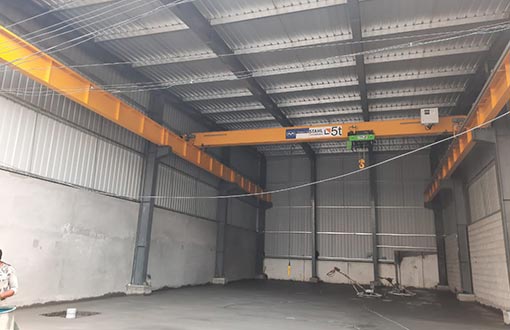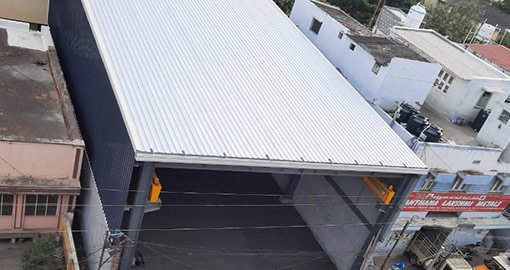PEB
Pre-Engineered Building (PEB buildings)
In structural engineering, a pre-engineered building (PEB) is designed by PEB contractors or by PEB manufacturers to be fabricated using the best-suited inventory of raw materials available from all sources and manufacturing methods that can efficiently satisfy a wide range of structural and aesthetic design requirements. Within some geographic industry sectors, these structures are also known as pre-engineered metal buildings (PEMB) or as engineered metal buildings (EMB), which is becoming more common due to the reduced amount of pre-engineering involved in custom computer-aided designs.
Other forms of primary framing can include trusses, mill sections rather than three-plate welded, castellated beams, etc. The choice of economic form can vary depending on factors such as local capabilities (e.g. manufacturing, transportation, construction) and variations in material vs. labour costs.

Primary frames are typically 2D frames (i.e. may be analysed using two-dimensional techniques). Advances in computer-aided design technology, materials, and manufacturing capabilities have helped in developing alternative pre-engineered building types such as tension fabric buildings and more sophisticated analysis (e.g. three-dimensional) as required by some building codes.
Cold-formed Z and C-shaped members can be used as secondary structural elements to fasten and support the external cladding.

Engineers consider the clear span between bearing points, bay spacing, roof slope, live loads, dead loads, collateral loads, wind uplift, deflection criteria, internal crane system, and maximum practical size and weight of fabricated members when designing a pre-engineered building. Pre-engineered building manufacturers have traditionally developed pre-calculated tables for various structural elements to allow designers to choose the most efficient I beam size for their projects. With the advancement of computer-aided custom designs, table selection procedures are becoming increasingly rare.
Advantages of Pre-Engineered Buildings
Pre-engineered building construction is unquestionably one of the world’s fastest-growing construction systems. All parties involved in the project find its benefits appealing. Who can argue with a construction system that provides speed, quality, and value, after all? Pre-engineered buildings have a number of advantages over traditional steel buildings. In addition to the lower initial cost and faster delivery, you will only have to deal with one pre-engineered building manufacturer KMR Construction for the design and fabrication of your PEB buildings. Alternative structural framing options are substantially costly to build so that pre-engineered building systems are considered economic and cost-efficient. Contrary to the conventional permanent brick-and-mortar structures PEB structures allow on-site modification and enhancement with their pre-engineered structures. A well-designed pre-engineered building can be up to 30% lighter than a conventional steel building. Lighter weight means less steel and potentially lower structural framework costs. Pre-engineered buildings are designed and constructed to last. PEB structures are made of top quality and highly durable materials, are designed to cope with the most severe weather and natural disasters. PEB structures are simple to construct and transport. Because the majority of the components are pre-engineered, PEB building structures are easy to transfer and assemble.
With KMR Construction the best pre-engineered building manufacturer in Coimbatore, you can get your most desired and customized PEB structures. KMR Construction has established itself as the most dependable pre-engineering building company in Coimbatore, as recommended by the top companies.
Applications of PEB buildings
Pre Engineered buildings range in size from small car parking sheds to large factory buildings with clear spans and multi-storied structures. The pre-engineered building approach has been used for almost every conceivable building application. Metal building framing styles each have their own set of benefits. The framing system you choose is usually determined by the quality of the structures, the project budget, and the local building code. On an existing building structure, a single slope structure is used for offices and large warehouses. If you want to make the most of your space for shorter spans, straight column framing is the way to go. The most common application of PEB buildings is in commercial, industrial, institutional, and agricultural buildings.
These types of PEB building we have constructed
- Single slope PEB building
- Ridged frame PEB building
- Arch type PEB building
- Pre-fabricated roofing structures
- Customized PEB building
- Pre-engineered industrial structures
- pre-engineered commercial buildings

